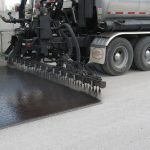What Is Cutback Bitumen?
Adding certain amounts of petroleum distillates such as kerosene to the Bitumen will results in “Cutback Bitumen”. This is done to reduce the viscosity of the bitumen temporarily so that it can penetrate pavements more efficiently and/or to allow spraying at temperatures that are too cold for successful sprayed sealing with neat bitumen. The materials used for cutback bitumen will evaporate after application to leave the remaining material similar in hardness to the original bitumen.
| BITUMEN MC 30 | ||
| Characteristic | Value | Test Method |
|---|---|---|
| Kinematic Viscosity at 60°C (cSt) | 30-60 | ASTM D-2170 |
| Flash Point (top open cup)(°C) | 38 min | ASTM D-3143 |
| Distillate, %volume of total distillate to at 360°C: To 225°C To 260°C To 316°C |
25 max 40-70 75-93 |
ASTM D-402 |
| Residue from Distillation to 360°C (%Vol by difference) | 50 min | |
| Test on Residue from Distillation | ||
| Viscosity at 60°C | 30-120 | ASTM D-2170 |
| Penetration at 25°C (dmm) | 120-250 | ASTM D-5 |
| Ductility at 25°C (cm) | 100 min | ASTM D-113 |
| Solubility in Trichloroethylene (%wt) | 99 min | ASTM D-2042 |
| Water Content (%vol) | 0.2 max | ASTM D-95 |
| BITUMEN MC 70 | ||
| Characteristic | Value | Test Method |
|---|---|---|
| Kinematic Viscosity@ 60°C (cSt) | 70-140 | ASTM D-2170 |
| Flash Point (Top open cup)(°C) | 38 min | ASTM D-3143 |
| Distillate, %volume of total distillate to @ 360°C: to 225°C to 260°C to 316°C |
20 max 20-60 65-90 |
ASTM D-402 |
| Residue from Distillation to 360°C (%Vol by difference) | 55 min | ASTM D-402 |
| Test on Residue from Distillation | ||
| Viscosity@ 60°C (cSt) | 30-120 | ASTM D-2170 |
| Penetration @ 25°C (dmm) | 120-250 | ASTM D-5 |
| Ductility @ 25°C (cm) | 100 min | ASTM D-113 |
| Solubility in Trichloroethylene (%wt) | 99 min | ASTM D-2042 |
| Water Content (%vol) | 0.2 max | ASTM D-95 |
| BITUMEN MC 800 | ||
| Characteristic | Value | Test Method |
|---|---|---|
| Kinematic Viscosity@ 60°C (cSt) | 800-1600 | ASTM D-2170 |
| Flash Point (top open cup)(°C) | 66 min | ASTM D-3143 |
| Water Content (%vol) | 0.2 max | ASTM D-95 |
| Distillate, %volume of total distillate to @ 360°C: to 225°C to 260°C to 316°C |
— 0-35 45-80 |
ASTM D-402 |
| Residue from Distillation to 360°C (%Vol by difference) | 75 min | ASTM D-402 |
|
Test on Residue from Distillation |
||
| Penetration @ 25°C (dmm) | 120-250 | ASTM D-5 |
| Ductility @ 25°C (cm) | 100 min | ASTM D-113 |
| Solubility in Trichloroethylene (%wt) | 99 min | ASTM D-2042 |
| BITUMEN MC 3000 | ||
| Characteristic | Value | Test Method |
|---|---|---|
| Kinematic Viscosity at 60 °C (cSt) | 3000-6000 | ASTM D-2170 |
| Flash Point (top open cup)(°C) | 66 min | ASTM D-3143 |
| Distillate, %Volume of Total Distillate to at 360°C: To 225°C To 260°C To 316°C |
— 0-15 15-75 |
ASTM D-402 |
| Residue from Distillation to 360°C (%Vol by difference) | 80 min | ASTM D-402 |
| Test on Residue from Distillation | ||
| Viscosity at 60°C | 30-120 | ASTM D-2170 |
| Penetration at 25°C (dmm) | 120-250 | ASTM D-5 |
| Ductility at 25°C (cm) | 100 min | ASTM D-113 |
| Solubility in Trichloroethylene (%wt) | 99 min | ASTM D-2042 |
| Water Content (%vol) | 0.2 max | ASTM D-95 |
Packing
- Drum 208 litr (0.8 mm Thickness )
Application of Cutback Bitumen
-
-
Prime and Tack Coating
The process of priming involves applying a low viscosity binder to a prepared but usually unbound aggregate base. It is intended to be absorbed by the top layers of the base and provide a surface more easily ‘wetted’ by a subsequent bituminous covering. The primer will be able to carry traffic for a short time (although this practice is uncommon) and help control dust. Generally, primers are applied at rates between 0.5 and 1.4 L/m2. Priming-suitable cutback bitumen are also used for tack coats, which are applied to an underlying surface to help with the adhesion of subsequent asphalt layer. A typical application rate is between 0.2 and 0.4 L/m2.
-
Prime Sealing
Where temperatures are too cold for an effective priming operation, or where traffic is likely to distress a primed surface before the final seal can be sprayed, a primer seal can be used to provide adequate protection of the pavement for periods of up to 6 to 12 months. Cutback bitumen suitable for primer sealing can also be used in the production of pre-mix asphalt, which is used in patch repairs.
-
Spray Sealing
Cutback bitumen are used more usually in sprayed sealing applications, particularly in colder temperature where they provide improved initial stone retention due to their lower viscosity. Typically, a single application of the appropriate cutback bitumen is sprayed onto the primed pavement onto which aggregate is laid.
-
Prime and Tack Coating
The process of priming involves applying a low viscosity binder to a prepared but usually unbound aggregate base. It is intended to be absorbed by the top layers of the base and provide a surface more easily ‘wetted’ by a subsequent bituminous covering. The primer will be able to carry traffic for a short time (although this practice is uncommon) and help control dust. Generally, primers are applied at rates between 0.5 and 1.4 L/m2. Priming-suitable cutback bitumen are also used for tack coats, which are applied to an underlying surface to help with the adhesion of subsequent asphalt layer. A typical application rate is between 0.2 and 0.4 L/m2.
-
Prime Sealing
Where temperatures are too cold for an effective priming operation, or where traffic is likely to distress a primed surface before the final seal can be sprayed, a primer seal can be used to provide adequate protection of the pavement for periods of up to 6 to 12 months. Cutback bitumen suitable for primer sealing can also be used in the production of pre-mix asphalt, which is used in patch repairs.
-
Spray Sealing
Cutback bitumen are used more usually in sprayed sealing applications, particularly in colder temperature where they provide improved initial stone retention due to their lower viscosity. Typically, a single application of the appropriate cutback bitumen is sprayed onto the primed pavement onto which aggregate is laid.



